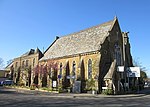Borough of Waverley
Borough of WaverleyBoroughs in EnglandNon-metropolitan districts of SurreyPages with non-numeric formatnum arguments

The Borough of Waverley is a local government district with borough status in Surrey, England. The council is based in the town of Godalming. The borough also contains the towns of Farnham and Haslemere and numerous villages, including the large village of Cranleigh, and surrounding rural areas. At the 2021 Census, the population of the borough was 128,200. The borough is named after Waverley Abbey, near Farnham. Large parts of the borough are within the Surrey Hills Area of Outstanding Natural Beauty. The neighbouring districts are Guildford, Mole Valley, Horsham, Chichester, East Hampshire, Hart and Rushmoor.
Excerpt from the Wikipedia article Borough of Waverley (License: CC BY-SA 3.0, Authors, Images).Borough of Waverley
Ockford Road, Waverley
Geographical coordinates (GPS) Address Nearby Places Show on map
Geographical coordinates (GPS)
| Latitude | Longitude |
|---|---|
| N 51.184291666667 ° | E -0.61758055555556 ° |
Address
Ockford Road
Ockford Road
GU7 1QU Waverley
England, United Kingdom
Open on Google Maps










